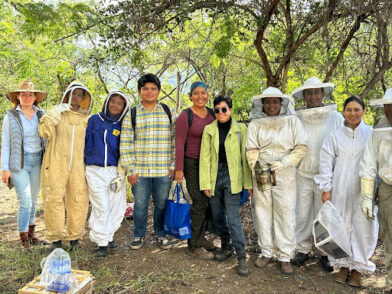
A principios de 2023, profesores de la Universidad de Colima iniciaron un proyecto destinado a categorizar diferentes tipos de miel de Colima. Este proyecto comenzó en el 2015, cuando el equipo de la Universidad de Colima comenzó a buscar financiamiento para el estudio de la flora polinífera y nectarífera del estado de Colima. Estos estudios […]
Read More… from Ayudando a los Apicultores de Colima
Like many other African cities, Lusaka is facing rapid urbanization and various challenges related to inequality, climate change, economic opportunity, and service delivery. The city is faced with limited technical capacity to deliver essential services to all 3.3 million people and with a growth rate of about 5% annually, Lusaka’s Local Authority is unable to […]
Read More… from Lusaka’s Expanding EPIC Partnerships Look to Solve Capacity Issues
With this knowledge we used the portion of the fire hydrants addresses provided by the city of Seaside fire department to geocode their locations in order to analyze them. With this knowledge we used the portion of the fire hydrants addresses provided by the city of Seaside fire department to geocode their locations in order […]
Read More… from Seaside Fire Department Incident Data Analysis
We began our project based on our research question: How does aspect and elevation affect native plant species density and distribution on sand dunes located on the central coast of California? To answer this question we analyzed how aspect, slope, and elevation affect the growth of native species found along the rear dune areas of […]
Read More… from Native Plants on Seaside Dunes
To spatially analyze Fire Department accident data in the city of Seaside, California from the dates March 25, 2015 to March 30, 2015. The accidents will be interpreted in groups based on land type in which they occurred. The four land types investigated in this project are “developed – open space”, “developed – low intensity”, […]
Read More… from Traffic Accidents versus Land Type in the City of Seaside
To consolidate the two data sets (InletsByZone and swInlet) taken of Salinas’ stormwater inlet drains, data points were verified and validated through a series of steps; if the points on both data sets’ overlapped, the data point was considered verified, if the points differed slightly or only one layer was present, Google Earth’s “street-view” feature […]
Read More… from Stormwater inlets in the City of Salinas- Data dictionary and gap analysis
This semester, the City has worked extensively on building an online platform capable of being used by the students to collect high accuracy GPS data from their own mobile devices. This approach uses new GPS receiver technology that is being lent out by the City of Bozeman GIS department directly to the students participating in […]
Read More… from Public Art map web overlay
This project was conducted for the city of Salinas to assign geographic coordinates to a large set of public data, so that the city is able to obtain the locations of business licenses visibly by using ArcGIS. Our team was assigned approximately 8,252 total businesses and we had to verify the address location to ensure […]
Read More… from Geocoding business licenses in Salinas
This project was completed as part of the 2018-2019 Resilient Communities Project (rcp.umn.edu) partnership with Ramsey County. Ramsey County wanted to assess the accessibility for visitors and clients of County-owned service facilities to make informed decisions about future capital investment in or relocation of these facilities to better meet the needs of the public. Ramsey […]
Read More… from Putting Residents First: Accessibility of County Service Facilities
